Because of Women
By Bowdoin MagazineBy Mary Pols
Illustration by Franziska Barczyk
Alumnae from across five decades convened in September to share stories of their Bowdoin experiences, both joyful and difficult. They celebrated female leadership and fortitude in the early days of coeducation, in the present, and into the future.
When Bowdoin opened its doors to women, the College wasn’t prepared for the actuality of female students. Things had to change. Bowdoin women asked for that change, took the lead in creating it, and continue to embody transformative power as cultural and societal perspectives shift.
Dora Anne Mills ’82, P’24 remembers a key moment during her tour of the Bowdoin campus as a high school senior. Like many women of her era, she’d been encouraged to apply by male relatives who were alumni from the days before women could earn a Bowdoin degree—in her case, two uncles.
As the tour circled the Quad and reached the Visual Arts Center, the guide segued into the topic of Bowdoin’s shift to coeducation. In the fall of 1977, coeducation was still relatively new.
Mills listened, thinking that, for the guide at least, there seemed to be a correlation between coeducation and the new art building, which had opened in 1975. This sent a message that Bowdoin expected women students would need and appreciate arty things—soft humanities—and had delivered. “I don’t know how explicit it was,” said Mills, who was planning to major in biology and would go on to earn a medical degree. Today she is the chief health improvement officer of MaineHealth, the state’s largest integrated health care system. “But it definitely made an impression.”
In all likelihood, that was intentional. By the time the Governing Boards voted in favor of coeducation in September 1970, arguably the most monumental moment in Bowdoin’s history since its founding, there had been several years of discussion about what women would want and need from Bowdoin. There was consultation with peer institutions that had already started the process of coeducation—this was a trend nationally—and sharing of findings. An ad hoc committee studying coeducation had said expansion of the College’s art instruction facilities was already advisable, “even without the introduction of women.” With them, it said, “it becomes imperative.”
Women didn’t “necessarily bunch up” in the humanities, the committee said, but the College still might need “to give wider offerings in music, art, and languages.”
From the hindsight of fifty years, it might seem as though Bowdoin’s leaders initially approached coeducation the way a group of Jane Austen’s better bachelors might plan a dinner party. Women were to be welcomed—there was hope they’d elevate the discourse, smooth out some of Bowdoin’s rowdier edges, and help the College grow—but what women would want and how they would fit in was a puzzle.
Incorporating women fully into Bowdoin’s culture, both as students and as faculty and staff, would ultimately take a full generation and lots of campus leaders, many of whom honed their skills by pushing back against tradition. This past September, alumnae from across those years, including Mills, gathered virtually for a two-day celebration titled “Leaders in All Walks of Life: Fifty Years of Women at Bowdoin.”
They shared stories of both joyful and hard times, and considered the meaning of a fiftieth anniversary and coeducation becoming what some might describe as “officially middle-aged.” “It seems a real corner turned,” said Marilyn Reizbaum, Harrison King McCann Professor of English and the director of the Gender, Sexuality, and Women’s Studies Program.
As tends to happen whenever a vital corner is turned, Bowdoin’s women are looking back at the progress forward. Even for women who loved their Bowdoin experience, who have sent their daughters to the College, or who work there today, not every memory of being a student in those early days is sweet. As they look back, they’re doing so with more awareness than ever of the complexities of gender and sexuality and the essential need for equity and inclusion.

They’re also highly conscious of how impossible it is to separate the time spent at Bowdoin from the eras themselves. In the tumultuous ’70s, Bowdoin was part of a wave of coeducation happening at colleges in the Northeast, including Princeton in 1969, Wesleyan in 1970, Dartmouth in 1972, and Amherst in 1975. The national conservatism of the ’80s was reflected on campus and so too was the shift to a more technology-connected and -driven world in the ’90s and ’00s, as well as the social justice movement of the past decade.
“I think it was no different from any other school that coeducated at that time,” said Melanie May ’82. She never felt excluded or discouraged. She worried more about socioeconomic differences with her classmates than the issue of gender. She had strong friendships with men.
But May and other alumnae also describe some blurred lines. Or, for some, there was a sense of not fully belonging. And, in some cases, that feeling lingered until the final markers of patriarchal history specific to Bowdoin fell away, including changing the college alma mater from “Rise Sons of Bowdoin” to “Raise Songs to Bowdoin” in 1994; the number of women in the student body edging out men for the first time in 1992; the decision in 1997 to end fraternities; and, finally, the first gender parity of the faculty in 2009.
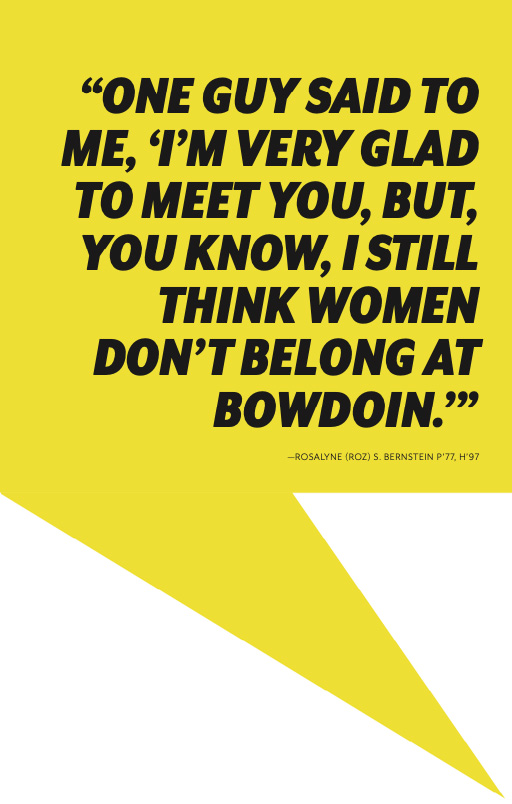 “I hear more stories as an alum than I ever knew as an undergraduate,” said Bridget Spaeth ’86, who has worked at the College since 2002 and is currently academic department coordinator for earth and oceanographic science. That was one of the reasons she and other organizers of the September events wanted to focus on both the impact of women on the College and the impact of the College on women. The #MeToo movement has changed how many women look at their pasts, Spaeth said. “I think all of us have more language now and some perspective for unpacking all the dynamics in the classroom with faculty, with peers, in social life, leadership, and just student opportunities.” She, like May, points out that in the ways it may have struggled to be truly inclusive of women, Bowdoin was far from unique. “A lot of institutions were dealing with this.”
“I hear more stories as an alum than I ever knew as an undergraduate,” said Bridget Spaeth ’86, who has worked at the College since 2002 and is currently academic department coordinator for earth and oceanographic science. That was one of the reasons she and other organizers of the September events wanted to focus on both the impact of women on the College and the impact of the College on women. The #MeToo movement has changed how many women look at their pasts, Spaeth said. “I think all of us have more language now and some perspective for unpacking all the dynamics in the classroom with faculty, with peers, in social life, leadership, and just student opportunities.” She, like May, points out that in the ways it may have struggled to be truly inclusive of women, Bowdoin was far from unique. “A lot of institutions were dealing with this.”
Coeducation began in earnest with the admission of the Class of ’75, but for several decades, women arrived at Bowdoin without understanding that the process of coeducation might still be ongoing. “I had no perspective,” Kate Dempsey ’88 remembers of her eighteen-year-old self. “Twelve years is actually a really short amount of time in the history of any organization.”
The first woman to serve on Bowdoin’s Board of Overseers, and later a trustee, the late Rosalyne (Roz) S. Bernstein P’77, H’97 described the early women at Bowdoin as “tough” and “gutsy” in an interview before her death. That description fit Bernstein herself. When she joined the board in 1973 she vowed to be a positive presence, never a token. She would not be, as she told then-president Roger Howell when he asked if he could nominate her, a shrinking violet. “When I went to my first meeting, you know, everyone was most cordial,” Bernstein said. “But one guy said to me, ‘I’m very glad to meet you, but, you know, I still think women don’t belong at Bowdoin.’” Fine, she said, then politely reminded him he was in the minority.
And he was. But all the way through the ’70s and ’80s, men like him popped up, often in the pages of the Orient, to express similar views, as if coeducation might still be dropped, like a curricular requirement or an unpopular club, if enough people complained.
In those early years, there were many battles to be fought, from asking for better gynecological care (and birth control) and for resources in athletics to getting protections from sexual harassment to making sure women were treated with respect. Sometimes it was language (referring to a “girls’” team when its counterpart was the “men’s” team) and resolved relatively easily. Cultural issues went deeper, and in many cases, the passage of time was the crowbar that ultimately led to their removal. In those early days, particularly, there were no ground rules around relationships between faculty and students. One woman remembers the awkwardness of receiving an unexpected and undesired marriage proposal from her professor upon her graduation. Another recalls sitting across from her professor at the Chuck Wagon restaurant as he complained about another student who had just broken up with him. Then there were rumors about a powerful professor who drove more than one woman out of his department, either through snide criticism or outright sexual trespass.
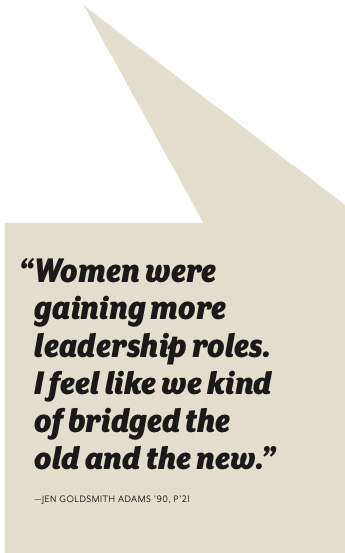
“We knew we had trouble with some professors,” Roger Howell said in an interview about coeducation in 1980, two years after he stepped down from the presidency. Howell was frank about what still needed work (security, facilities, and equal access for women on the faculty) as well as the College’s lack of preparedness for coeducation. “We stumbled through it,” Howell said. “I think with the help of an awful lot of good grace from the first couple of years of students that came through the program.”
Those classes were mighty in spirit but small out of necessity; the College simply didn’t have the facilities for women, including enough dormitory space or places for them to eat. Most students relied on fraternity kitchens for their meals. (In that era, Moulton Union had capacity to serve about 280 students, and Wentworth, in what is now Thorne Dining Hall, could feed about 300.) Generally speaking, Bowdoin’s first women students could eat in the fraternities, but policies varied, with some fraternities drawing the line at full membership or allowing women to live in the buildings. Others fully embraced them; Psi Upsilon elected Patricia “Barney” Geller ’75, P’08, P’12 its president the spring of her first year.
Yet despite such markers of acceptance, the early women at Bowdoin faced some hostility from their male classmates. The Orient polled students about coeducation and published the results in February 1972, along with some choice misogynistic comments. One commenter described “co-eds” as “a bunch of Helens” breaking down the walls of Troy. Another accused them of being wallflowers.
They were never bystanders, though. They took to the classrooms, and they took to the playing fields. A field hockey program began in 1971 and was officially named a team by 1972. It was coached by Sally LaPointe, who was married to men’s coach Mort LaPointe and who initially began coaching as a volunteer. Her first field hockey teams wore cast-off men’s soccer uniforms.
By the time Kate Dempsey arrived in the fall of 1984, planning to play field hockey, the team finally had uniforms, but they were shared with lacrosse, Dempsey’s other sport. Dempsey had formulated social justice instincts during her youth in Philadelphia, and so when she stood in line to get her BCAD gray shirts and shorts from the athletic department, she took note that the men were getting an extra piece of equipment. “Jockstraps,” Dempsey said. “There barely was such a thing as a sports bra then, but I just kept pestering people, like, ‘If the guys get jockstraps, can’t we get sports bras?’”
It was a little thing, she said, but “it was an emblem to me, of just everything. The difference between what the men were getting and what we were getting.” Around her junior year, the man behind the counter finally offered her a sports bra along with her BCAD shirt. And the lacrosse team got its own uniforms.
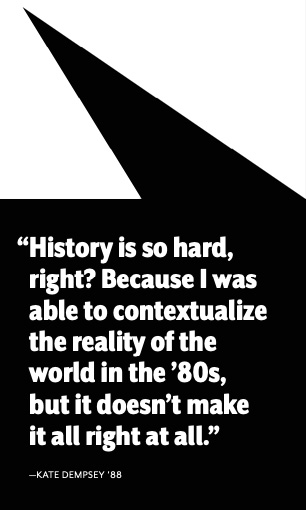
Dempsey was one of many agents of change who spoke up and let Bowdoin know what its women needed. “Student passion really is what gets things going at Bowdoin,” said Spaeth. “Bowdoin is responsive to students when they organize.” In her era as a student, Spaeth notes, she saw students learning from mentors on the faculty, women who were very skilled at analyzing power structures and working within them.
But in the ’70s, the response could take some time. In May 1974, the Bowdoin Women’s Group sent a letter to the College, signed by both women and men, asking for gynecological services on campus and for the infirmary to be staffed differently: “Many students sense the infirmary is reluctant to deal particularly with birth control and related concerns because of their own traditional or moral values.” A letter from another group, the Concerned Black Women, noted that “A doctor that [treats] broken arms and legs cannot be expected to deal with the personal medical problems of women with the same expertise” and urged Bowdoin to make “necessary changes in the medical facilities.” Bowdoin did, although not until 1977, when a part-time nurse practitioner was hired to provide gynecological care.
By 1976, the total campus population had grown but was still male-dominated, with twice as many men as women. Men were accepted to the class of ’79 at a rate of 18.9 percent, while women’s acceptance rate was 12.7 percent. Professors were aware that higher standards were being unfairly applied to women. As a corrective, in 1976, the Governing Boards announced that Bowdoin would start admitting men and women in the same proportions that they appeared in the applicant pool.
As the student demographics shifted, women wanted a faculty that included more people who looked like them. Records from 1976 show a total of nine women teaching at Bowdoin, only two of them full professors, three of them instructors. “It was shocking,” said Linda Nelson ’83. She, like many others, can count on one hand how many women they had as teachers at Bowdoin: Joan Tronto in government; Barbara Kaster in English (“heroic,” Nelson said); Barbara Held, who arrived in 1979 (“she looked younger than us,” Mills remembers of her psychology professor); German professor Helen Cafferty, who taught the first course that could be considered a women’s studies class, a literature course that focused on women in German literature.
The patriarchy was dominant, but it could not and would not remain so. “The arrival of women here started to shift patriarchal culture,” Nelson said.
Getting caught in the middle of a shift could be demoralizing. That’s what happened when Mills pledged Zeta Psi as a first-year. She hadn’t planned on rushing, but she and her roommate felt close to others in the frat, which had made room for women to be full members within the Bowdoin community. Three fraternities on campus were still limiting women to a “social” status only, but the faculty passed a resolution in February 1979 that they had to “be free of any discrimination based on sex,” with a two-year grace period to carry out that resolution. The New York Times published a story about the resolution on February 6, 1979.
Then, in March, Zeta Psi received word from its national office that it had to either declare its women social members only or be cast out of the national organization. There was disagreement in the ranks, but the fraternity alumni, or “elders,” owned the building, and ultimately Zeta Psi closed its doors to women having full voting membership. The College didn’t have an alternative space where the Zeta Psi refugees could live together. “We got kicked out,” Mills said. “Now we were joining a small minority of people. There wasn’t another social network.”
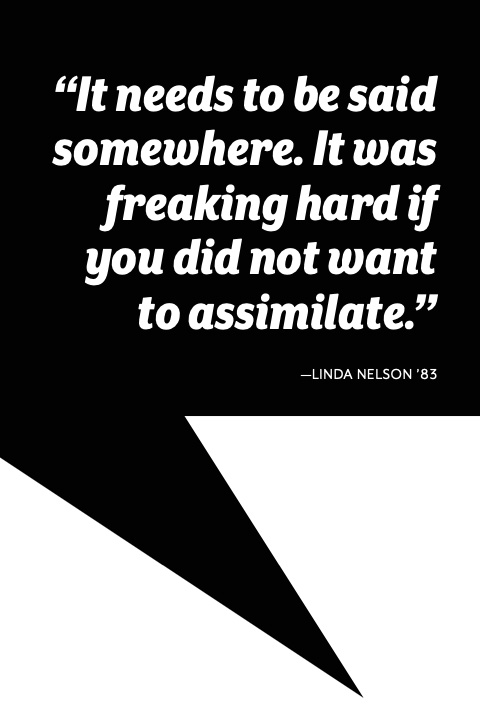
But there was a striking counterpoint to that feeling of being excluded. The month after the Zeta Psi expulsion of women, Bowdoin senior Joan Benoit (Joan Benoit Samuelson ’79, P’12) was the first woman across the finish line at the Boston Marathon, breaking the previous women’s record. She did it wearing a Bowdoin singlet. One of Mills’s fondest memories is of being in Wentworth when “Joanie” came through the dinner line that night. Mills was in awe of her grit and determination, and she was surrounded by others who felt that way; she remembers every student in Wentworth rising to their feet to give Joanie an ovation.
In a 1981 letter to the Orient after Chi Psi went through a similar situation to Zeta Psi’s, Mills called on her fellow students, men and women, to be leaders and take a stand. Today Mills reflects on how Bowdoin and peer institutions were learning alongside their women. “There is no road map as to how you should become coed,” Mills said. And she thinks of how these experiences informed her as she encountered sexism in “the real world,” particularly professionally, and gave her tools to deal with it. “It was so blatant, so right out there,” she said. “It did prepare me in many ways for being part of the male-oriented institution of medicine.”
Others were leading the way by carving out spaces for women. The Bowdoin Women’s Association had been accumulating a small library of books about and for women, and a group asked if that library could be housed at 24 College Street, a new residence for women. Approval was given, and the Women’s Resource Center was born in 1980.
“The founding of the Women’s Resource Center is a milestone action,” Nelson said. Nelson was openly gay and jokes that she was also “out as a feminist.” At Bowdoin, that made her feel as if she’d been dropped onto another planet. “It needs to be said somewhere,” Nelson said. “It was freaking hard if you did not want to assimilate.” She spent a year at Wesleyan and contemplated never returning. But she missed Bowdoin’s academic rigor and, when she went back, the Women’s Resource Center that she helped found was growing, along with student desire for a curriculum around women’s issues.
She sees it as a turning point for the College, and certainly, more awareness of women’s rights followed. The women’s ice hockey club was ready to be a varsity team and to be respected as such. “We get ice after the high school and the naval base,” player Linda Miklus ’83 told the Orient in 1982. (The club became a team in 1984.) There was more recognition, and concern, about the role alcohol played on campus. A sexual assault of a student in Coles Tower in 1980, and another of a summer music festival student in 1982, raised awareness of a need for improved security. Security phones were installed around the campus in December 1982. Male students volunteered as a shuttle service, and some spoke out for women. After an offensive cartoon about trapping women in a room until they “submit” appeared in the Orient in early 1983, a member of the Class of 1986, writing to the Orient, decried what he saw as a “criminal lack of respect for women” on campus. Campuswide conversations about sexual harassment—and the need for a policy protecting students from it—followed, starting with a symposium called “Women/Men: Bowdoin and Beyond,” organized by a group of students, including Barbara Geissler ’85, as well as faculty and staff.
Their voices might not have brought about immediate change, but they were heard. In his Report to the College in early 1984, President Roy Greason called for more women on the faculty and staff, citing the need for women students to have them as role models and counselors. He described a “new will” to realize these goals. In the next self-study, in 1986, there was increased awareness that women’s unmet needs on campus had to be resolved. That included protecting them from sexual harassment within the student body. Efforts to identify offenders had been mostly unsuccessful, Bowdoin said.
“It is increasingly clear that the College must undertake a much stronger educational role in this respect.” That same year, a six-week maternity leave for faculty and staff was instituted. The women’s singing group Miscellania asked to be able to sing the national anthem at hockey games; the Meddiebempsters had been territorial about owning the tradition at the highly popular events. Greason determined they should split the honor evenly.
Cultural programming in those days was dynamic and reflective of an institution seeking to include women’s voices, which benefited all. Consider the fall of 1987, when Toni Morrison came to campus to speak about her new novel, Beloved, and academic Andrea Parrot visited to give a lecture about intimate relationships.
Then in November 1987, two women reported being sexually threatened and assaulted in a fraternity by two men they’d considered friends. The men were suspended, and then charged with violating Bowdoin’s Social Code by returning to campus after being told to leave, but for weeks a debate over whether this was a prank or a crime played out in the pages of the Orient.
For Kate Dempsey, this was a pivotal moment. She and her friends had systems intended to keep each other safe around men and alcohol at parties. In retrospect, she shakes her head at how normalized such a response was, not just at Bowdoin but for women everywhere. “History is so hard, right? Because I was able to contextualize the reality of the world in the ’80s, but it doesn’t make it all right at all.”
“Many of us felt like it [the culture] was predatory and substance-driven,” Spaeth said. “Maybe we were just hitting it at a time when things had really devolved.” Physically, some fraternities had gotten run down; the energy crisis of the 1970s meant that more of their budgets were spent heating the places than maintaining them. Greason noted this in his annual report and suggested a connection between derelict houses and derelict behavior.
“One thing students from the ’80s will say is, we had leadership opportunities,” Spaeth said. “We were meeting each other’s needs.” In 1988, Greason formed a special board on sexual harassment, led by Kaster and mathematics professor Wells Johnson. In that same year, women’s studies was officially recognized as a minor (it became a major in 1992) and the Children’s Center was established on campus.
“It was an evolving time for women on the Bowdoin campus,” said Jen Goldsmith Adams ’90, P’21, now a Bowdoin trustee. She was president of Psi Upsilon and the Interfraternal Council. “Women were gaining more leadership roles. I feel like we kind of bridged the old and the new.”
Student gender parity had still not quite been achieved by the time a new president, Robert Edwards, arrived at Bowdoin in 1990. Women made up 44.6 percent of the student body. Just four years into Edwards’s tenure at Bowdoin, that percentage rose to 51.3 percent, but Bowdoin leadership was focused on what was still missing: “Many aspects of gender equity have been addressed, but many women on campus still feel their experience at Bowdoin differs from that of men, and that they have fewer opportunities to learn, to grow, and to succeed,” the 1996 reaccreditation report said. While in some cases fraternities had successfully evolved into coeducational social organizations, their very name, fraternity, “sends a symbolic message to women about their status in these groups, and perhaps at Bowdoin generally.” After a visiting student fell from the roof of Chi Delta Phi and died, Bowdoin convened the Commission on Residential Life to study the social and residential life at the College.
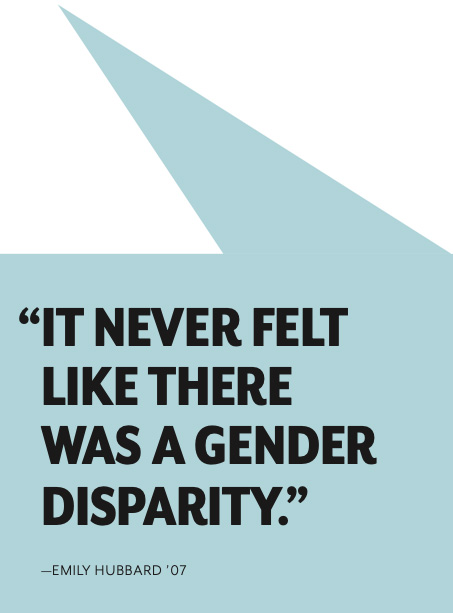
In 1997, after the Commission completed its work and submitted its report to the board, the College announced that fraternities would be closed and their buildings bought by the College to be transitioned to social houses. Some mourned, others felt relief. “I was glad,” said Taryn Bowe ’99. As a first-year student in 1995, she’d found the fraternity and partying culture off-putting and unsafe.
The College was in a time of change, with plans to increase student enrollment by 10 percent over a four-year span while pushing forward with Bowdoin’s Diversity Plan, intended to increase diversity at all levels of the College. The expansion opened up new positions, and with them, opportunities for both women and minority professors. By the time Emily Hubbard ’07 arrived at Bowdoin from Memphis in 2003, the majority of her professors were women. “It never felt like there was a [gender] disparity,” Hubbard said. She worked as a proctor, and there, “I did have concerns for women in social settings at times. But I think it is just a reality of the culture that we live in. Any college is going to be a microcosm of that.”
As a Black woman in a class that she remembers as having only ten other African American students, she experienced a sense of being in the minority but “Bowdoin really went out of its way to make sure we were OK.” She said she viewed adaptability to a predominantly white culture as “akin to assimilation,” as well as a path to success. But fifteen years after leaving Bowdoin, Hubbard sees adaptability as a way to broaden one’s opportunities. For her, that included law school and now a job at the Department of Justice, where she drafted the department’s first transgender equity policy. “I loved Bowdoin,” she said.
What is Bowdoin today, at this landmark moment? It is a place made better by women. The offerings that were intended to draw women, from art to music to theater and dance, have made it a richer college for all. It is a place where Bowe, who lives in Brunswick, brings her children to the National Girls and Women in Sports day events hosted by Bowdoin athletes and revels in the atmosphere. “There are just some really badass women that are there.”
It is a place that continues to inspire Susan Graves Teare ’87, who left Bowdoin with lifelong friends (and a spouse), an old Minolta that would help set her on a path to a career in photography, and faith in herself. “I still hold the standards that I encountered at Bowdoin to this day,” Graves Teare said. “From myself, I expect great things. I expect to work with integrity and authenticity in whatever I do to make a living and to enter out into my community with those values.”
For Marina Affo ’17, Bowdoin was a place where, yes, she could see “the remnants” of its former all-male existence, but it’s also the place where she made her closest friends and connected with most of the names in her “little black book” of professional contacts. It’s where she found the skills that have helped her fulfill her seventh-grade dream of becoming a journalist. “I would not be where I am today without people from the Orient,” she said. One of her editors there, Nora Biette-Timmons ’14, recommended Affo apply for an internship at ProPublica. “I told her, ‘I think it is a stretch, but I will do it anyway because I look up to you.’” Affo landed it, and only five years out of Bowdoin, she’s on the investigative team at The Philadelphia Inquirer. Among her journalistic “gurus”? Veteran NBC correspondent Cynthia McFadden ’78, H’12 who checks in once a year or so to see how her young Bowdoin sister (and fellow Lewiston-Auburn native) is doing.
It is also a place that welcomes the daughters of its early daughters. Dora Anne Mills’s daughter Julia Mills Fiori is a member of the Class of ’24. Like her mother, Julia plans to become a doctor, but there is no chance she will count her Bowdoin women professors on only one hand.
Julia’s classmates are a diverse population that extends far beyond men and women. “This generation is much more aware that there are more than two genders,” Mills said. Reflective of that, the Women’s Studies Program that began in 1988 is now the Gender, Sexuality, and Women’s Studies Program. The Women’s Resource Center is now called the Sexuality, Women, and Gender Center (SWAG). Both are thriving. And when Julia took her tour, there was no meaningful pause at the Visual Arts Center. The Quad is barely touched by time, but Bowdoin has been changed—for good—by its fifty years of women.
Mary Pols works in communications at Bates College. Her father, Ed Pols, was a Bowdoin philosophy professor, and her mother, Eileen Pols, and sister, Alison Pols, both earned a Bowdoin degree in 1979. When niece Katy Reid graduated in 2005, they became the first three-generation group of Bowdoin women.
Franziska Barczyk is a Toronto-based illustrator, gif maker, collage, and visual artist. Find more of her work at franziska.co.

This story first appeared in the Winter 2022 issue of Bowdoin Magazine. Manage your subscription and see other stories from the magazine on the Bowdoin Magazine website.